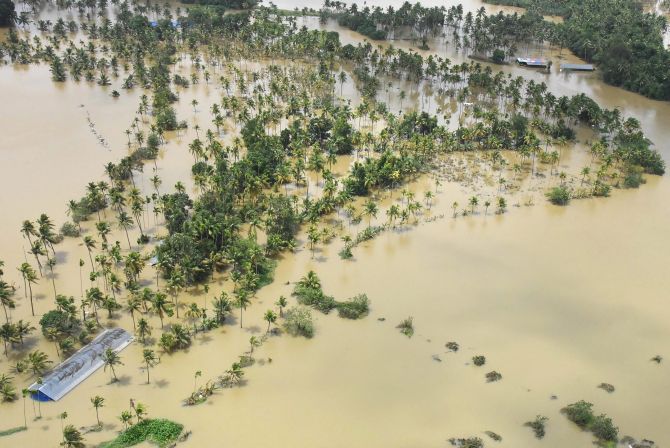Flood in the rice bowl: Keralites who lost everything stare at uncertainty.
Gireesh Babu reports from Kuttanad.

With large parts of the state still reeling from the ravages of the floods, Kerala is staring at a grim Onam this year.
Saturday is the main feast of the festival, which celebrates the legend of the asura king Mahabali's annual visit to earth from netherworld.
But there are no merrymakers this time.
Missing are the snake boat races and the revellers dressed as Mahabali.
And missing too are the lush green paddy fields: they are inundated with flood water and the crops are all destroyed.
"We won't have Onam this year. I think it will be several more days before I get to see my house and fields out of water," says 68-year-old Gopalan, who is staying at a relief camp in Alappuzha, which is part of Kuttanad, the rice bowl of Kerala.
When Gopalan and his family were rescued from their house, the water was already chest-high.
D Lakshmanan, Pallathuruthy ward councilor, and head of the relief camp at a school in Thiruvambadi, Alappuzha, says: "Almost 200,000 people have been rescued and there are 62 relief camps in Alappuzha alone."
"The water is receding slowly and it may take another 10 days for it to be fully drained," says Vinod V, a farmer in Kuttanad.
"The land needs to be prepared for cultivation by November and we don't know if it will be possible," he says.
Having lost their crops, farmers like Vinod also wonder how they will repay the loans they have taken.
According to the UN Food and Agricultural Organisation, the Kuttanad Wetland Agriculture System is unique as it is the only place in India which favours rice cultivation below sea level in land that was created by draining the delta swamps.
In fact, it was awarded the Globally Important Agricultural Heritage System tag for its unique agricultural heritage.
But today, the entire Kuttanad region, including Chambakkulam, Nedumudi, Kavalan, Kayikkara and many others, has been devastated.
And it's not only the wasted croplands -- after being underwater for more than a week, many houses have developed cracks. The chances of some of them collapsing cannot be ruled out.
The mood is not much different in Kochi, Kerala's financial capital.
While it was not as badly hit as Kuttanad, water from Periyar inundated much of Kochi's streets and those of neighbouring towns like Aluva.
"This is the busiest season for traders and shopkeepers, but business has been at a standstill for the last two weeks," says a tailoring shop owner.
Many industrial units are running with low manpower, as most of the employees have still not returned home from the camps.
Needless to say, the loss to business has been staggering.
"We are yet to analyse the losses," says Damodar Avanoor, state president of Kerala State Small Industries Association.
There are about 135,000 small scale units in Kerala, and Avanoor says they will request the state and the central governments for special packages or exemptions as relief measures.
The floods have also dealt a heavy blow to Kerala's plantation sector.
Ajith Balakrishnan, secretary, Association of Planters of Kerala, pegs the losses at around Rs 8 billion. The worst affected are the plantations in Idukki, Wayanad, and Nelliyampathi in Palakkad, places which are still mostly inaccessible.
The government's initial estimate of the losses is about Rs 200 billion to Rs 300 billion. But the figure could climb higher.
"We have not assessed the full extent of the damage as yet and will approach the government for assistance soon," says S Sajikumar, chairman of the CII Kerala State Council.
Meanwhile, most agree that the state and other agencies have done a sterling job in the relief camps.
At the Thiruvambadi camp a doctor visits every day and treats the sick. The food is good too, say the people.
However, some complain that while food is not a problem, the distribution of clothes has not been even-handed.
"The councillor is giving all the new clothes to his relatives and giving us the old stuff," alleges Sophy, a housewife, who lost her paddy field and some 150 ducks to the flood. But the government and relief camp authorities say that they are not even accepting old clothes for fear of infection and disease.
Relief measures to help people pick up the pieces of their lives are underway.
Banks are rescheduling loans to farmers and the government too has announced steps to reduce their burden. People are slowly going back to their homes now.
Chief Minister Pinarayi Vijayan said that the number of people in the camps has come down from 1.2 million to 1.04 million on Thursday, August 23.
However, the long road to rebuild Kerala has only just begun.












 © 2025
© 2025